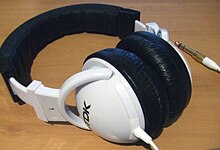Noise-canceling headphones
A noise reducing headset or noise-reducing headphone is used as ear protection for eliminating background noise in the reproduction of wanted sound . The useful sound can be reproduced at a lower or more tolerable volume . To reduce noise, passive damping through sound-absorbing materials and active noise reduction through anti- noise are used.
functionality
The headphones pick up the sound from the outside with one or two integrated microphones , which is then reproduced via a built-in amplifier with its own power supply and opposite polarity signal flow via the headphones' loudspeakers . The original sound is extinguished or at least weakened by destructive interference and only the previously mixed useful signal remains. This principle only works sufficiently well at low frequencies in the audible range up to a few 100 Hertz. At high frequencies, passive damping, also known as noise isolation, is much more effective thanks to insulating materials in the headphone housing.
Headphones with integrated, active noise cancellation are available in the following designs :
- On-Ear (on-ear headphones )
- Over-Ear (circumaural headphones )
- In-ear (in-ear headphones)
The headphones require their own power source for the active noise reduction function. This is provided in the form of a battery or a rechargeable battery.
history
The Nobel Prize winner Lord Rayleigh discovered the principle of active noise suppression for the first time in 1878. He was familiar with the ability to interfere with optics and transferred it to noise. Using two tuning forks, he localized maxima and minima. Rayleigh recognized the principle but was unable to put it into practice.
A benefit from the recognized ability to interfere did not arise until 1934 through Paul Lueg and Henri Marie Coanda . Active noise reduction was expressed for the first time in Lueg's patent. But even here it remained with theoretical, albeit much more precise approaches.
In 1949, Bichovskij recognized the possibilities of anti-noise, so he applied for a patent for noise-reducing headphones, but did not realize it.
The first practical experiments on active noise cancellation were carried out in 1953. However, due to the lack of technology at the time, no practical benefit was derived from the experiments.
In 1988, the noise-reducing headphones were finally implemented using digital technology. Back then, the Bose company designed the first headphones with anti-noise technology.
Initially, the headphones were intended for aircraft pilots so that they could communicate with the ground crew. The headphones were later sold commercially.
Areas of application
Noise-reducing headphones are used wherever audio signals are to be transmitted to the ear in areas with loud ambient noise , such as in the cockpit of an aircraft for radio communications or for communication between pilots on board. But passengers in noisy vehicles also use such headphones, for example to listen to music as relaxed as possible during the trip. Furthermore, the noise from electrical devices such as the noise from fans , air conditioning systems or electric motors can also be reduced in the interior area.
The advantage of noise-reducing headphones is that the reduced overall sound level at the ear reduces the burden on auditory perception as well as the emission of useful sound from the headphones into the environment. Noise-reducing headphones can also be used to reduce noise without the application of a useful signal.
The disadvantage is that these headphones require a power supply from batteries , accumulators or other voltage sources. Some devices cannot reproduce useful signals without a power supply. Since the headphones work like active speakers with internal amplifiers that are optimized for the built-in loudspeakers, the original useful signals can be changed to a greater or lesser extent or falsified with additional noise, for example noise . In the case of useful signals in the speech area, it must also be ensured that the headphone wearer reduces their own speech volume.
providers
Well-known manufacturers or brands of noise-reducing headphones are, for example, AKG , Apple , Beats , Blaupunkt , Bose , Creative , Denon , JBL , JVC , Panasonic , Philips , Sennheiser , Sony , Teufel and Vivanco
Individual evidence
- ↑ Reinhard Lerch, Gerhard Sessler, Dietrich Wolf: Technical acoustics: Fundamentals and applications . Chapter 14.7.3 Headphones - types of headphones , Verlag Springer, 2008, ISBN 978-3-540-23430-2 , p. 431.
- ↑ An Engineer Explains the Magic of Bose's New Headphones. July 20, 2019, Retrieved October 3, 2019 (American English).

